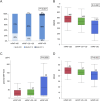Clinical impact of mean pulmonary arterial pressure after balloon pulmonary angioplasty for inoperable chronic thromboembolic pulmonary hypertension
- PMID: 40912892
- PMCID: PMC12414211
- DOI: 10.1136/openhrt-2025-003532
Clinical impact of mean pulmonary arterial pressure after balloon pulmonary angioplasty for inoperable chronic thromboembolic pulmonary hypertension
Abstract
Background: Balloon pulmonary angioplasty (BPA) improves haemodynamics in patients with inoperable chronic thromboembolic pulmonary hypertension (CTEPH). Previous studies on BPA have set the treatment objective to achieve a mean pulmonary arterial pressure (mPAP) of <30 mm Hg. However, the clinical impact of mPAP after BPA remains unclear. This study aimed to stratify patients according to their mPAP after BPA and evaluate its association with clinical status and long-term outcomes.
Methods: We retrospectively reviewed 304 patients with inoperable CTEPH (median age, 72 (61 to 79) years) who underwent BPA and follow-up right heart catheterisation. Patients were categorised by mPAP after BPA: ≤20, >20-<30 and ≥30 mm Hg groups.
Results: The WHO functional classification, 6 min walk distance and right ventricular ejection fraction were significantly better in the group with a lower mPAP (trend test p=0.007, p<0.001 and p=0.002, respectively). Additionally, the proportions of patients who required pulmonary vasodilators or oxygen therapy were significantly lower in the group with a lower mPAP (trend test p<0.001 and p<0.001, respectively). Across all multivariable models, the mPAP ≥30 mm Hg group had a significantly poorer prognosis compared with the mPAP ≤20 mm Hg group. In contrast, no significant difference was observed between the mPAP ≤20 mm Hg and >20-<30 mm Hg groups.
Conclusions: In patients with CTEPH after BPA, an mPAP of <30 mm Hg was associated with a favourable prognosis, and patients with an mPAP of ≤20 mm Hg presented with better symptoms, exercise capacity, right ventricular function and more withdrawal from oxygen therapy and pulmonary vasodilators. The BPA treatment goal may require individual adaptation.
Keywords: Cardiac Catheterization; Hypertension, Pulmonary; Outcome Assessment, Health Care.
© Author(s) (or their employer(s)) 2025. Re-use permitted under CC BY-NC. No commercial re-use. See rights and permissions. Published by BMJ Group.
Conflict of interest statement
Competing interests: KT received grants from Abbott Medical Co., Ltd., AMI Co., Ltd., Boehringer Ingelheim Japan, Boston Scientific, Japan K.K., Daiichi Sankyo Co., Ltd., ITI Co., Ltd., Ono Pharmaceutical Co., Ltd., Otsuka Pharmaceutical Co., Ltd., and Takeda Pharmaceutical Co., Ltd. and honoraria from Abbott Medical Co., Ltd., Amgen K.K., AstraZeneca K.K., Bayer Yakuhin, Ltd., Daiichi Sankyo Co., Ltd., Janssen Pharmaceutical K.K., Kowa Pharmaceutical Co. Ltd., Kyowa Kirin Co., Ltd., Nippon Boehringer Ingelheim Co., Ltd., Novartis Pharma K.K., Novo Nordisk Pharma Ltd., Medtoronic Japan Co., Ltd., MSD K.K., Otsuka Pharmaceutical Co., Ltd., Pfizer Japan Inc., Takeda Pharmaceutical Co., Ltd., and Terumo Co., Ltd. TO received honoraria from Nippon Shinyaku Co. and Janssen Pharmaceutical K.K. outside of the submitted work. All other authors declare no conflict of interest.
Figures




Similar articles
-
Effect of riociguat on exercise following balloon pulmonary angioplasty in patients with inoperable chronic thromboembolic pulmonary hypertension in Japan (THERAPY-HYBRID-BPA): a multicentre, double-blind, randomised, controlled, phase 4 trial.Lancet Respir Med. 2025 Sep;13(9):789-799. doi: 10.1016/S2213-2600(25)00127-4. Epub 2025 Jul 23. Lancet Respir Med. 2025. PMID: 40714010 Clinical Trial.
-
Medical Therapy Versus Balloon Angioplasty for CTEPH: A Systematic Review and Meta-Analysis.Heart Lung Circ. 2018 Jan;27(1):89-98. doi: 10.1016/j.hlc.2017.01.016. Epub 2017 Mar 1. Heart Lung Circ. 2018. PMID: 28291667
-
Effect of Combination of Balloon Pulmonary Angioplasty and Medical Therapy on Reverse Right Ventricular Remodeling and Hemodynamics in Chronic Thromboembolic Pulmonary Hypertension.J Invasive Cardiol. 2023 Jun;35(6):E312-E320. doi: 10.25270/jic/23.00060. J Invasive Cardiol. 2023. PMID: 37410748 Free PMC article.
-
Hemodynamics assessment using 4D flow CMR before and after balloon pulmonary angioplasty in chronic thromboembolic pulmonary hypertension: a retrospective observational study.BMC Cardiovasc Disord. 2025 Aug 21;25(1):621. doi: 10.1186/s12872-025-05068-x. BMC Cardiovasc Disord. 2025. PMID: 40841600 Free PMC article.
-
Balloon Pulmonary Angioplasty for Chronic Thromboembolic Pulmonary Hypertension: A Systematic Review and Meta-analysis.Cardiovasc Intervent Radiol. 2023 Jan;46(1):5-18. doi: 10.1007/s00270-022-03323-8. Epub 2022 Dec 6. Cardiovasc Intervent Radiol. 2023. PMID: 36474104
References
MeSH terms
LinkOut - more resources
Full Text Sources
Medical
